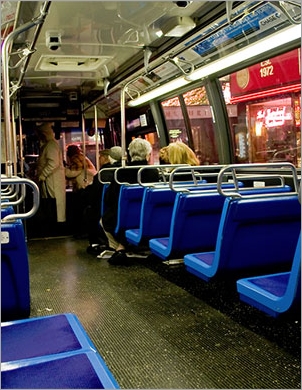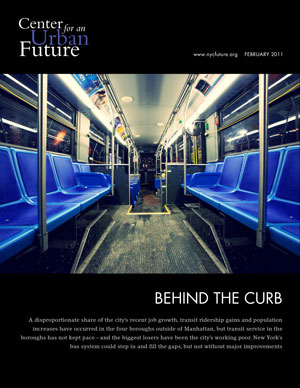Good afternoon. My name is David Giles and I am the Research Director at the Center for an Urban Future, an independent policy institute that publishes studies about how to grow and diversify New York's economy and expand economic opportunity.
In February 2011, the Center published a study which found that New York City's public transit service has not kept pace with recent job growth and commuter trends in Brooklyn, the Bronx, Queens and Staten Island.
Our report, titled "Behind the Curb," documented that a growing number of New Yorkers are commuting to work outside of the two Manhattan Central Business Districts (CBDs). We found that over the past two decades, in every borough outside of Manhattan, the number of workers who commute to jobs across their own borough or to a neighboring borough or county has been growing much faster than those who make the more tradition trip into Midtown or Downtown Manhattan. So for example, between 1990 and 2008, the number of Bronx residents who travel to Queens or Westchester County for work grew by 38 percent and the number who travel inside the borough jumped by 25 percent; in the same period, the number commuting to Manhattan increased by just 13 percent. The number of Staten Island residents who travel to work in their own borough increased by 32 percent, while those going to Brooklyn or New Jersey increased by 22 percent. During the same period, the number of Staten Islanders commuting to work in Manhattan barely changed at all�a four percent increase in those 18 years. The number of Brooklyn residents crossing the border to Queens grew 32 percent between 1990 and 2008, while the number going to Manhattan increased by 13 percent in the same period.
As we show in our report, these trends are evidence of a dramatically changed economic geography in New York. Hard as it is to believe, outer borough job centers like East Flatbush, Sunset Park, Morris Park, Hunts Point, JFK, Flushing and Jamaica have been growing jobs at a faster pace than Manhattan's two CBDs. In fact, over the last ten years, Manhattan had a net loss of roughly 110,000 jobs while each of the four other boroughs experienced positive job growth. Our report showed that the biggest reason the boroughs have done so well over the last decade is their strength in two rapidly expanding sectors: health care and educa¬tion. Overall, between 2000 and 2009, New York City experienced an increase of almost 86,000 jobs in the health care indus¬try and 32,000 jobs in education. A vast majority of the health care jobs are located in the boroughs outside of Manhattan, at hundreds of rapidly growing outpatient clinics, doctors' offices, home health agencies and hospitals. Many of the education sector jobs were also in the boroughs.
Despite the fact that transit ridership patterns have been shifting, with more people working in the boroughs, the study found that the Metropolitan Transportation Authority (MTA) and New York City Department of Transportation (NYCDOT) have not made the investments necessary to keep up with these trends. And the biggest losers in all this have been New York City's working poor. New York's low-income workers are enduring longer commutes than ever and, in many cases, are cut off from decent-paying job opportunities because of limited transit connectivity. Our report argues that changes to the city's underperforming bus system could improve the lives of the working poor while helping to sustain economic growth in areas of the city that are poorly served by transit.
New York's transit system wasn't designed for commuter trips to jobs within and be¬tween boroughs outside of Manhattan, and as a result the city's median commute times have been rising steadily for decades. According to Census data released last year, New York's four outer boroughs all lead the nation in median commute times. For transit riders, they range from 52 minutes each way in Brooklyn to a barely comprehensible 69 minutes each way in Staten Island.
For our report, we spoke to a number of large outer borough employers who said that a lack of sufficient transit hurts their businesses. Among other things, it shrinks their labor pool and causes more turnover as disgruntled employees decide to leave rather than suffer through two hour commutes every day. The Chief Operating Officer at SUNY Downstate Hospital in East Flatbush Brooklyn even told us that a lack of sufficient transit could cause the hospital to rethink its plans for expansion. "Kings County and SUNY Downstate Hospitals are the second and fourth largest employers in the borough," he said. "But we get ignored."
Without question, the city should look at a diverse number of solutions to this problem, including expanded commuter rail, improved subway service and even bike lanes. But, if long commute times are ever going to be alleviated, the city's bus system will have to play a big role as well. The report commends the MTA and DOT for starting to implement some promising changes, including new or proposed SBS lines in every borough but Queens and an expanded real time bus tracking program. But much more needs to be done. In particular, the MTA has so far been reluctant to break out of the existing bus network to create an essentially new BRT system that could attract more riders and increase efficiency. As a minimum, the agency should be looking for ways to link major outer borough job centers: For example, with such dense clusters of workers, an SBS line running from downtown Flushing, in Queens, to downtown Jamaica, or even JFK airport, should be a no brainer.
The MTA could also extend several existing SBS routes. For example the B46, which runs along Utica Avenue and Broadway in Brooklyn, could be extended across the Williamsburg Bridge to connect with the M15 at Allen Street; right now, the bus terminates on the Brooklyn side of the bridge, as does the proposed BRT service for that route. Similarly, the M15 along First and Second Avenues could be extended up Third Avenue in the Bronx to connect with the Bx12 on Fordham Road.
To paraphrase a transit expert in our report, "The way things are now the borders between the boroughs are like real political borders, you can't get across them." But if New York is going to sustain job growth in the boroughs and retain a truly world-class transit system, solutions like these will have to be found and implemented.



